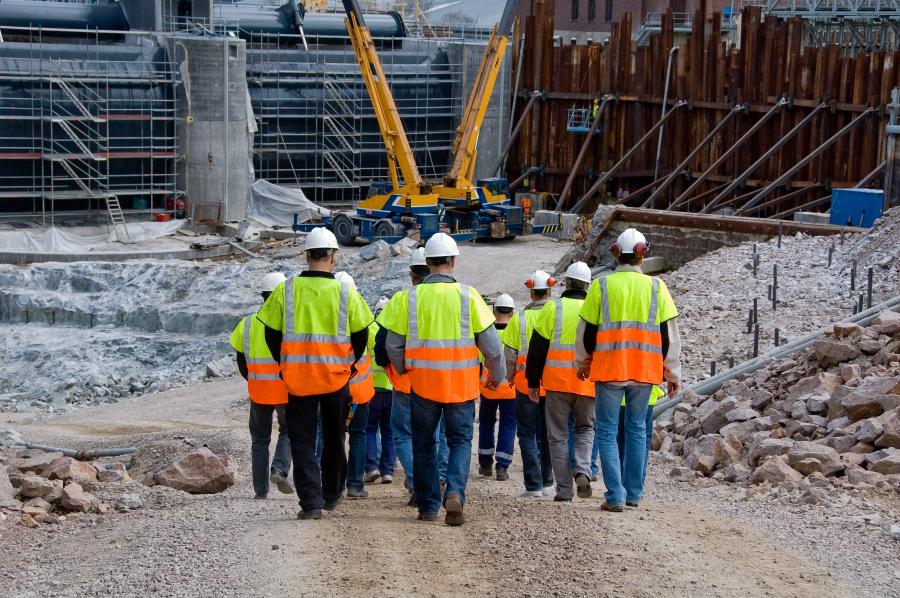Employment numbers in the construction industry are on the upswing. But jobs are still open everywhere, and contractors are desperate to fill them.
Construction employment is on an upward path and that's both good and bad. By extension, if jobs increase, so does the need for workers. And that's the continued challenge for the industry: contractors are beating the bushes for skilled labor to meet their labor needs.
The AGC reports that as the construction sector was adding 15,000 jobs in April, the industry jobless rate was falling to a record low.
"The number of unfulfilled construction positions is close to a monthly high," said the association.
As a whole the industry likely would have added even more to its rolls if contractors could find more qualified workers.
"Contractors can't find, reach, hire and train workers fast enough to keep pace with demand," said Stephen E. Sandherr, association CEO. "The pool of qualified, available labor is the smallest the industry has ever seen for the month of April."
How Numbers Shake Out
Construction employment rose from April 2022 to April 2023 in 42 states and the District of Columbia. While the numbers declined in seven states, they held their own in Hawaii. This from an AGC's break-down of BLS statistics:
Texas added 28,000 jobs; New York, 13,400; Indiana, 11,200; and Florida 8,600. At 5,500 new jobs, Arkansas marked the largest increase by percentage, 9.8 percent. Rhode Island followed at 7.6 percent. California logged the highest number of jobs lost, at 5,100; Connecticut lost 1,900 jobs; and West Virginia dropped 1,200 jobs, minus 3.7 percent).
West Virginia had the largest percentage loss at 3.7 percent, according to the AGC analysis. Connecticut and Alaska lost 2.5 percent, or 400 jobs.
For the month of April 2023, construction employment increased in 24 states and D.C. Hiring declined in 26 states. Washington added the most jobs over the month, at 4,300; Illinois added 2,700; Wisconsin, 2,600; and California, 2,100.
The largest percentage gain occurred in South Dakota, at 2.7 percent. Wisconsin, Washington and Arkansas saw a 1.8 percent gain, with 1,100 new jobs.
Dropping 8,500 jobs, Texas lost the most in April; New York lost 4,000. Alaska had the largest percentage loss for the month at 4.2 percent and 700 jobs.
AGC tracked two construction labor reports, one of which noted total construction starts in current dollars fell 4 percent from March to April. That number is 7 percent year-to-date, according to Dodge Construction Network.
Nonbuilding starts increased 16 percent year-to-date. Utility/gas plants are up 37 percent; miscellaneous nonbuilding starts, 36 percent.
Environmental public works projects are up 10 percent; and highway and bridge starts, 9 percent.
AGC analyzed a ConstructConnect report, which found that the value of construction starts in current dollars decreased 5.7 percent year-to-date.
Civil starts jumped 27 percent, seeing increases for all segments including roads, at 25 percent; and water/sewage, 23 percent.
Power and miscellaneous civil projects increased by 40 percent; bridges, 1.3 percent; dams/marine, 102 percent; and airports, 89 percent.
Picture Looks Bright and Bleak
In tracking the construction jobless rate over the past year, the AGC found a decline from 4.6 percent in April 2022 to 4.1 percent in 2023. Interesting in itself, that represents the lowest April rate in the 23-year history of the data.
At the end of March, the association noted, openings totaled 355,000, just shy of the all-time high for March of 359,000.
The construction sector shed 9,000 jobs that month, the first decrease since January 2022. This happened even as the sector's unemployment rate fell and total number of job openings in the sector hit a near-record high, according to AGC.
Average hourly earnings for production and nonsupervisory employees in construction jumped by 6.7 percent over the year to $33.94 per hour.
"Despite a small dip in headcount, construction firms continued to post a high level of job openings and raised pay more than other industries," said Ken Simonson, AGC's chief economist.
Those are two signs contractors still want to hire more workers, he said. "But the pool of unemployed, experienced jobseekers keeps shrinking."
Construction employment in March totaled 7,888,000, a dip of 9,000 or 0.1 percent from the record high in February. It was the first decrease in 14 months.
Nonresidential firms shed 1,800 employees in March. Employment at residential building and specialty trade contractors slipped by 7,000 or 0.2 percent.
The AGC reported the unemployment rate among jobseekers with construction experienced declined from 6.0 percent in March 2022 to 5.6 percent. That figure represents the second-lowest March rate in the 23-year history of the data.
"Exposing students and other future workers to construction will signal that it should be among the career paths worth considering," said Sandherr.
Construction firms in April provided a wage "premium" of nearly 19 percent compared with all private-sector production employees.
The industry is struggling to recruit workers while the federal government spends money to encourage students to go to college. These grads are encouraged to work in service sector professions for every dollar the government invests in career and technical education.
The AGC urged public officials to boost funding for construction education and training, and to explore short-term measures to address severe labor shortages.
"Federal officials are making massive investments in infrastructure while their funding policies discourage future workers from considering construction," Sandherr said. "They don't seem to want our citizens to work in construction even while they block people from other countries from lawfully entering the profession."
In March, AGC reported that many member firms need more workers but struggle to find enough qualified hires. The association called on the feds to boost investments in construction training and education programs to close the five-to-one gap.
"One of the biggest obstacles to hiring is the federal government's enormous campaign to urge students to pursue office-based service sector jobs," Sandherr said.
Those types of professions, in particular, require expensive four-year college degrees, he said.
"If the feds spent half as much encouraging students to pursue high-paying careers in fields like construction, our industry would have more workers and young adults would have less college debt."
A state-by-state analysis of BLS data released the ABC found that in March of this year, 31 states had lower construction jobless rates than March 2019 (pre-pandemic).
Over the same four-year period, 18 states had higher rates and Utah's rate was the same.
"High interest rates are creating headwinds for nonresidential construction projects," said Bernard Markstein, Markstein Advisors.
President and chief economist of the firm, Markstein conducted the analysis for the association.
"Until recently, construction employment continued to grow as builders worked on their backlog of projects," he said. "The March construction employment numbers were the first indication that employment growth in construction may be turning negative."
The increase of funds flowing from the federal Infrastructure Investment and Jobs Act to states and localities will partially offset the downward pressure in the residential sector. That, in turn, will provide opportunities for some unemployed workers and companies, said Markstein. The challenge remains in connecting the two groups.
ABC tracking models indicate that in 2023 about 546,000 more workers will be needed, beyond the "normal" pace of hiring, to meet the demand for labor.
"The construction industry must recruit hundreds of thousands of qualified, skilled professionals each year," said Michael Bellaman, association president. "Filling these roles with skilled craft professionals is vital to America's economy and infrastructure rebuilding initiatives."
This increased demand adds to the current level of above-average job openings. The association's model notes projected retirements, shifts to other industries and other anticipated separations are part of the computations.
The construction industry averaged more than 390,000 job openings per month in 2022. That's the highest level on record, and the industry unemployment rate of 4.6 percent in 2022 was the second lowest on record, according to ABC data.
That figure is higher than only the 4.5 percent unemployment rate observed in 2019.
National payroll construction employment was 231,000 higher in December 2022 than in December 2021.
"Despite sharp increases in interest rates over the past year, the shortage will not disappear in the near future," said Anirban Basu, ABC chief economist. "Contractors continue to experience substantial demand from a growing number of mega-projects associated with chip manufacturing plants, clean energy facilities and infrastructure."
Basu said too few younger workers are entering the skilled trades, which makes it not only a construction labor shortage but also a skills shortage.
"With nearly one in four construction workers older than 55, retirements will continue to whittle away at the construction workforce," he added. "Many of these older construction workers are also the most productive, refining their skills over time."
The number of construction laborers, the most entry-level occupational title, has accounted for nearly four out of every 10 new construction workers since 2012. Meanwhile, said Basu, the number of skilled workers has grown at a much slower pace or, in the case of certain occupations like carpenter, declined.
Next year, the association said, the industry will need to bring in more than 342,000 new workers on top of normal hiring to meet industry demand. That's presuming that construction spending growth slows significantly next year, according to AGC.
"To fill these important roles, ABC is working hard to recruit, educate and upskill the construction workforce," said Bellaman. CEG
Lucy Perry
Lucy Perry has 30 years of experience covering the U.S. construction industry. She has served as Editor of paving and lifting magazines, and has created content for many national and international construction trade publications. A native of Baton Rouge, Louisiana, she has a Journalism degree from Louisiana State University, and is an avid fan of all LSU sports. She resides in Kansas City, Missouri, with her husband, who has turned her into a major fan of the NFL Kansas City Chiefs. When she's not chasing after Lucy, their dachshund, Lucy likes to create mixed-media art.
Read more from Lucy Perry here.
Today's top stories

















